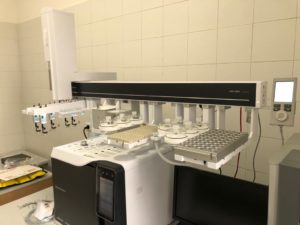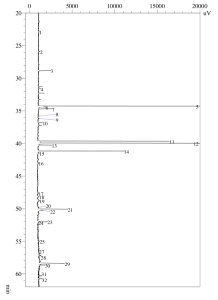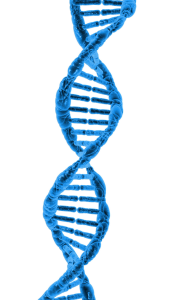LIPIDOMIC TEST
“Prevention” and “Cure” focus on identifying data and indices related to the monitoring of pathological states, through the use of tests connected to the specific purpose of interest. In this context, the Lipidomic survey, i.e. the mapping of the fatty acids which are in the red blood cells membranes, provides information to value patient’s health conditions, also considering the important functions that lipids perform within the organism.
The Lipidomic Test, from which a detailed picture of the fatty acid balance is obtained, provides essential data for the correct evaluation of the metabolic function of the subject and highlights any changes in physiological conditions, in order to allow a preventive or curative intervention, due to the presence or not of the pathology.
The human organism is able to synthesize fatty acids, starting from glucose and amino acids.
But some fatty acids, defined as essential (EFA), cannot be synthesized by the organism and must be introduced through food. The reason why a specific attention has been paid to the role of EFA is that they constitute all the biological membranes of every tissue in our body and determine their properties.
 There are two sets of essential fatty acids: omega-6 (ω-6) and omega-3 (ω-3). Many research studies showed that the balance of fatty acids and, in particular high levels of Ω-3, reduce the risk of occurrence of various kind of diseases. The monitoring of their contents within the blood provides for a half-yearly frequency connected to the metabolic characteristics of this class of compounds. EFA, in fact, are involved in most of the reactions that occur within the organism, playing a fundamental role in many pathologies.
There are two sets of essential fatty acids: omega-6 (ω-6) and omega-3 (ω-3). Many research studies showed that the balance of fatty acids and, in particular high levels of Ω-3, reduce the risk of occurrence of various kind of diseases. The monitoring of their contents within the blood provides for a half-yearly frequency connected to the metabolic characteristics of this class of compounds. EFA, in fact, are involved in most of the reactions that occur within the organism, playing a fundamental role in many pathologies.
Saturated Fatty Acids (SFA) are considered harmful to the organism and their surplus is connected to increased cholesterol and to the potential emergence of diseases such as diabetes, metabolic syndrome, cardiovascular disease, obesity, etc. SFA are particularly present in palm oil, peanut oil, eggs, butter, seasoned cheeses and processed meats.
Monounsaturated Fatty Acids (MUFA) are represented as a higher percentage by Oleic Acid (OA), present in all oils of vegetable origin, especially in olive oil. Another monounsaturated fatty acid, which is particularly important, is the Palmitoleic Acid (POA) of the Ω-7 series, recognized as an indicator of sugar excess in the diet.
Polyunsaturated Fatty Acids (PUFA) are considered health benefits. The essential fatty acids of the Ω-3 series and the Ω-6 series, represented respectively by Alpha-linolenic Acid (ALA) and Linoleic Acid (LA), belong to this group. Starting from these acids, by the action of enzymes, our organism synthesizes two sets of compounds: the ω-3 family fatty acids such as Eicosapentenoic Acid (EPA)and Docosahexaenoic Acid (DHA), and those of the family of Ω-6, Arachidonic Acid (AA), Gamma-linolenic Acid (GLA) and Diomo-gamma-linolenic Acid (DGLA).
The SFA/MUFA ratio is therefore indicative of the health and fluidity of the cellular membrane. High values represent an increase and accumulation of saturated fatty acids related to metabolic alterations or simply to a diet rich in them, with consequent imbalance at the level of the various systems and apparatus involved.
Advanced Lipid-I-ntelligence Test

Automatic Chromatograph
This test provides a detailed picture of the balance of fatty acids, provides essential data for the correct evaluation of the metabolic function of the subject and highlights any changes in physiological conditions, in order to allow preventive or curative intervention due to the presence or not of various pathologies related to Body Tissues (inflammatory states and neoplasms), to the Circulatory System

Test lipidomico – Cromatogramma tipo
(Cardiovascular disease, atherosclerosis, hypertension, dyslipidaemia), Endocrine System (Diabetes, Obesity, metabolic diseases, Thyroiditis), Digestive and respiratory tract (Crohn’s disease, cystic fibrosis, ulcerative colitis) , Immune System (eczema, atopic dermatitis, psoriasis, alopecia, rheumatoid arthritis), Reproductive System (premenstrual syndrome, female infertility (endometriosis, polycystic ovary syndrome), male infertility (sperm quality), breast and prostate neoplasms), Nervous System (development of the nervous system in the foetus, Alzheimer’s disease, SLA, autism, epilepsy, depression, macular degeneration, cataract, glaucoma), Bone Tissue (osteoarthritis, cervical) and Tegumentary Apparatus (hair loss and dandruff, dry skin, brittle nails, acne).
The Advanced Lipid-Intelligence Test is the only one that allows the identification of 31 fatty acids, useful to evaluate indices and reports indicative of the functioning of the metabolic pathways of the person.
The gas chromatographic analysis is carried out in a structure of Chromaleont S.R.L., a company that represents an excellence in the field of separations sciences, offering solutions for the development of analytical instrumentation and software dedicated to the Chemical analysis of complex matrices.
GENETIC TEST
The Guidelines for healthy nutrition, dietary advice and recommended daily doses of nutrients are standard, equal for all, and do not consider what constitutes inter-individual genetic variability and the response of each person to a particular food or association. Same food combinations produce different effects on different patients.
Complete Genetic Screening
This test is based on the analysis of more than 700,000 genetic polymorphisms, implicated in the detoxification process, in the inflammatory process, in the antioxidant activity, in the sensitivity to insulin, in the state of health of the heart, the bones, the mind and in the predisposition to cancer.
One of the investigated areas, the NUTRIGENETICS, is the study of how the variants of a gene, called polymorphisms, can influence the response of the organism after the ingestion of certain foods, generating pathological behaviours. In fact, in some patients, the diet can represent a serious risk factor for the development of certain diseases.
For example:
– the presence of HLA DQ2-DQ8-DR4 demonstrates an adverse gluten reaction that may be the cause of intestinal or general nonspecific disorders, up to the development of celiac disease;
– homocysteine metabolism is determined by an enzyme encoded by the MTHFR gene, which participates in the conversion of homocysteine to a harmless molecule;
– some genetic polymorphisms lead to an accumulation of toxic metabolites with increased risk of disease development.
Then the individual variety translates into a specific process of assimilation, metabolization and elimination of nutrients.
Here are some examples of genetic variants that influence the intake of nutrients by the organism.
If you have the variant of the ACE gene, it means that you have a higher salt sensitivity respect to the norm and an higher risk to developed hypertension, then the salt dose must not exceed 5.5 g per day. If you do not have this variant and have a normal salt sensitivity, the maximum recommended salt dose is 6 g per day.
 ALCOHOL
ALCOHOL
Who has the variant of the ADH1C gene is very sensitive to alcohol and metabolizes it slowly respect to the norm. It means that moderate consumption has a positive effect on cholesterol levels. Who does not have this variant, metabolizes it quickly and therefore has a higher risk of developing cirrhosis and cancer related to alcohol consumption.
If you have the variant of the APOC3 gene, you have to reduce the amount of saturated fats in your diet: instead of 22 g, as indicated by the guidelines, you don’t have to exceed 16 g.
COFFEE
The presence of the gene CYP1A2 * 1 means that you have to limit the amount of caffeine: no more than 2-3 coffees a day, because metabolite slowly caffeine. If you make a high consumption of coffee, more than 5 cups a day, increase the risk of heart attacks.
GRILLED MEATS
Who has the variant of the GENECYP1A2 * 1 must also limit the amount of grilled meat because it produces carcinogenic substances to which it is sensitive.
CRUCIFEROUS
Patients with the presence of the GSTM1 gene are advised to consume 3-4 times a week because they are more exposed to cancer risk.
FOODS WITH SATURATED FATS
When the APOC3 and LPL gene is present, fat-sensitive persons must limit their quantities to less than 16 g per day, and not 22g as for the official guidelines, to avoid increased cholesterol and triglycerides.

FLOUR FOODS
Who has the variant of ACE and PPARG genes must limit the amount of refined carbohydrates and increase the portions of fibres to reduce the risk of type II diabetes or metabolic syndrome. Also recommended at least 30 minutes of physical activity 3-4 times a week.
This system also offers an important help to the patient and to the doctor to implement a tailored dietary profile, as for to each individual genetic variable corresponds a precise variation in the metabolic structure of nutrients. The study of the metabolism of the individual patient implies the possibility to be able to choose and accurately combine the food to ensure the maximum guarantee in terms of results and to achieve an optimal lifestyle.
Multiple genetic analysis for the detection of tumour susceptibility offers the possibility to identify patients at risk of developing a neoplasm related to hereditary mutations, in order to have an early diagnosis and to reduce mortality, by implementing personalised active surveillance programmes.
Genetic tests for nervous system diseases are important in anxiety-depressive disorders and dietary behaviour, in particular the serotonin pathway, and in degenerative diseases such as Parkinson’s and Alzheimer’s.
Here are listed below the areas investigated by the Complete Genetic Screening
Nutrigenetics
Vitamin A, vitamin D, vitamin B6, vitamin C, Folic acid (MTHFR), caffeine sensitivity, anti-inflammatory ability, sensitivity to fats (triglycerides), sensitivity to fats (cholesterol), carbohydrate sensitivity, obesity, susceptibility to Celiac disease, lactose intolerance, nickel sensitivity, alcohol dependence, alcohol metabolism.
Prevention
Osteoporosis, metabolic syndrome, type II diabetes, cardio-vascular risk, thrombophilia, hypertension.
Mental health
Predisposition to Alzheimer’s disease, susceptibility to low serotonin levels
Oncological surveillance
Susceptibility to hereditary cancer, Melanoma, Pancreas, Stomach, Prostate, Breast, Ovaries, Uterus, Colon rectum









